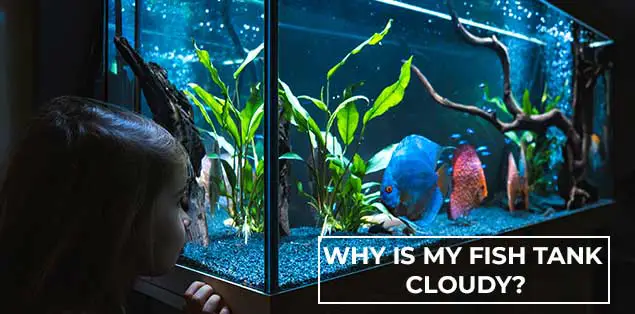So, why is my fish tank cloudy? Nothing is more frustrating than seeing your aquarium tank all cloudy. But why does this happen, and what are the circumstances that lead to it? Unfortunately, there may not be an easy solution, and several different factors may influence it.
Most of these factors are straightforward to address, but a handful may need a little more doggedness on your part. However, before we can apply the proper remedy to correct the water’s cloudiness, we have to figure out if the water is white/gray, brown, or green in appearance. Only then can we choose the right treatment.
So, let’s begin!
Why Is My Fish Tank Water Cloudy?
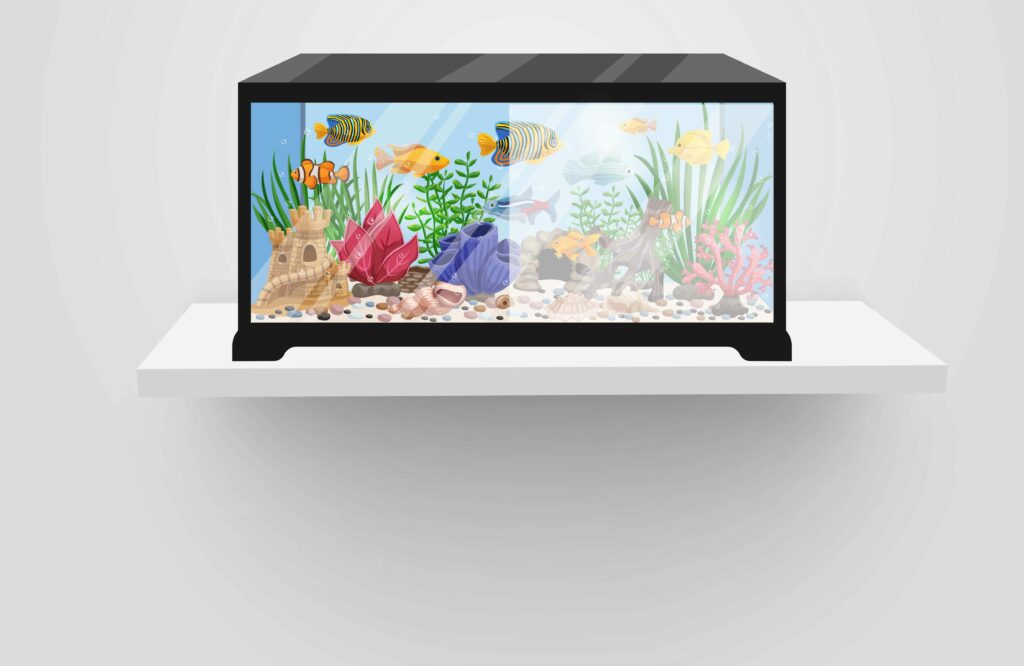
Here are some reasons why your fish tank is cloudy:
New Tanks and Cloudy Water
Our pastime entails both the maintenance of cloudy water and the purchase of a brand new fish tank. When cycling a tank or having a tank that you’ve just cycled for the first time, it is typical for something like this to occur.
When introducing additional animals to the fish tank, you bring in new sources of nutrients and waste for the tank to deal with. The system’s equilibrium is disrupted when you rapidly add new fish or materials.
Due to this imbalance, the helpful nitrifying bacteria in your tank will start reproducing at an alarming rate to digest the excessive nutrients. As a result, your water becomes cloudy due to the vast quantities of newly formed bacteria, which produce a cloud.
Being patient is the most effective strategy for finding a solution to this problem. Put an end to adding new fish, and let your tank have time to calm down. It should resolve itself without further intervention.
We recommend that you use an aquarium test kit to check the water quality in your aquarium during this period. You will want to keep an eye on the three major new tank metrics: ammonia, nitrite, and substrate levels. When you first get a new tank, ammonia and nitrite levels will be your top priorities in terms of water quality.
Overfeeding Fish
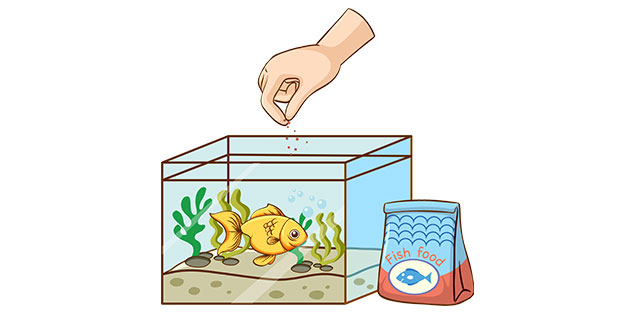
This is one of the most prevalent causes of cloudy water in fish tanks, especially if the aquarium has been lying for some time. It is natural to want to provide consistent food for your fish, and this desire is not unreasonable. After all, once they see you, they will often give you a kind smile and a greeting with their adorable tiny faces.
They wait for you to feed them as they stare at the top of the tank and you. If you start feeding them a lot, you will throw their system off balance, and a bacteria bloom will arise.
Take a break from feeding your aquarium inhabitants while you check the water quality in your tank. Allowing your fish to go without food for a day will give their digestive systems a chance to return to normal. The presence of an excessive amount of food is an issue that might cause the water in the aquarium to become cloudy.
You should not subject goldfish and other species of fish that do not have stomachs to this treatment under any circumstances. Be wary of automated fish feeders since it is simple to overfeed fish when using them.
Too Many Fish
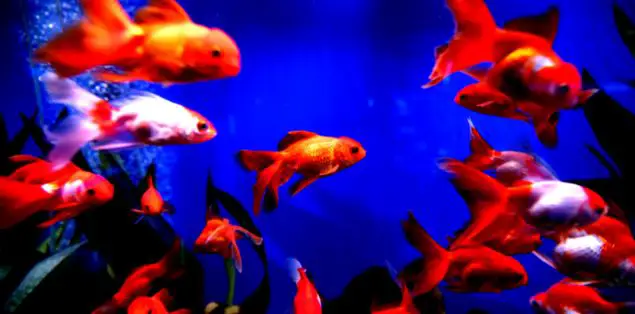
If too many fish are in the tank, the water will get cloudy, and the tank will have an unclean appearance. Hastily adding them can also result in the water becoming cloudy. Incorporating additions into your routine can help you move more slowly.
If the water is foggy, you should refrain from introducing additional fish until the cloudiness is under control.
You should avoid increasing the fish in your tank by more than fifty percent. Instead, it would be best if you spaced out the addition of new fish for four to six weeks at a time so that the ecosystem in your tank has time to adjust.
If you have done a dry start for a planted aquascape, then we believe this is the only circumstance in which you will be able to circumvent this requirement.
Inadequate Filtration
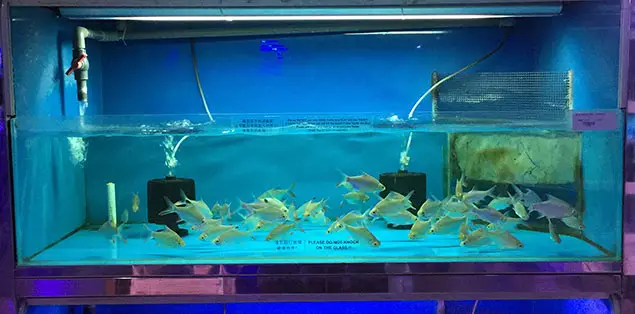
In a fish tank that has been running for some time, the cloudiness of the water is almost entirely due to the filtration process. Therefore, your use of mechanical filtration will almost certainly be the primary offender in this case. However, power filters often use coarse foam to keep costs down, which allows finer particles to flow through.
When it comes to canister filters, the problem that may be at hand is the selection of foam. For example, you can pick from various foam densities thanks to high-end manufacturers such as Biomaster Thermo, which provides more than one option. So if you have a tank crowded with inhabitants, you want to think about getting a much finer foam.
Suppose you are already using a power filter. In that case, you may want to give some thought to the possibility of adding a layer of filtration to enhance the efficiency of the mechanical filtering. For example, the blue floss used in canister filters and sumps is the one that we find to be the most effective. It is possible to make a bulk buy of it online and then cut it to the appropriate size.
Dead Fish Or Matter
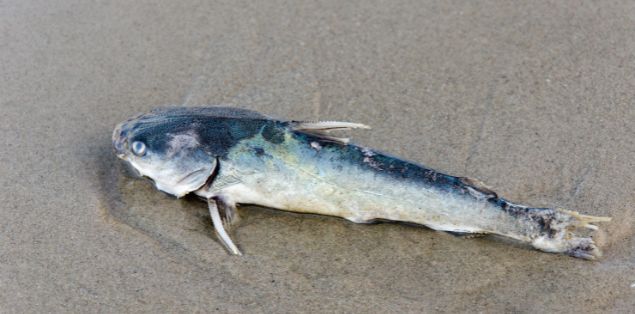
When organic matter decomposes, it may quickly cause the water in your aquarium to become cloudy. A deceased fish will provide the ecosystem with the largest chunk of decaying matter. Therefore, you should perform daily tank checks to ensure that all the fish in your collection are present and accounted for. For example, if your fish are reproducing, you could find that some of the fries have died and are now polluting the water in the tank.
The second element will be chunks of uneaten fish food and rotting plant materials. This is going to be a problem. Check for both of these things in the substrate. Remove any leaves from your living plants that seem to be rotting.
Your Glass
Your glassware may be causing the cloudiness in the water of your tank. However, the presence of bacterial biofilm is the primary contributor to the problem. The biofilm is most readily common on aquarium driftwood, but it may also form on the glass of your aquarium.
If you do not remove this biofilm from your glass, it will cause it to get foggy and cause it to stick. When you have a bigger fish tank, the water in your tank will have a very little tint, making the water seem darker. However, traditional glass aquariums will not have as clear an appearance as low-iron rimless aquariums and acrylic tanks, showing off their contents more effectively.
Your Substrate
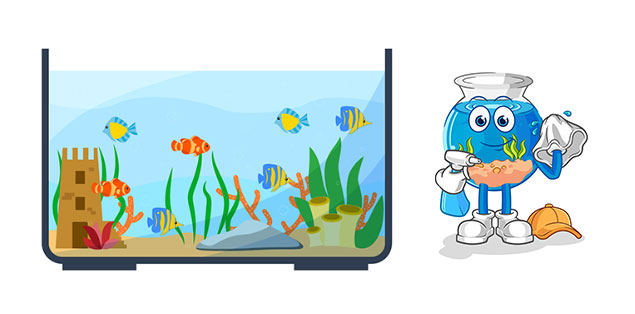
If you do not thoroughly clean the new substrates, the water in the tank may get cloudy. Therefore, before putting any substrate in your aquarium, you must always ensure it is well washed. The alternative possibility is that an existing substrate was present, which would be the second reason.
When you stir up an excessive amount of your substrate all at once, it might trigger the release of more nutrients. Hence, this results in a bacterial bloom or causes the water in your aquarium to become discolored. If you stir your substrate, the ideal time to do it is when you are gravel vacuuming.
This will allow you to collect most debris kicked up during the stirring process.
Why Is My Fish Tank Cloudy After Water Change?
Here are some possible reasons:
Overfeeding

It may obscure the water even if you don’t overfeed your fish. For example, you can blame a bacterial bloom or dissolving food particles.
Feeding many times a day is recommended on many fish food containers. This is OK, but if you’re going to do that, you need to know exactly how much food your fish are consuming and how much is getting wasted to the bottom of your tank. Uneaten food decomposes, and the water might get cloudy if there is enough of it.
This may happen in a big tank, but it is also a common problem for betta owners trying to keep their pets healthy. So to avoid polluting their tank, you should only feed them small amounts of fish flake or betta pellets every day.
Overstocking
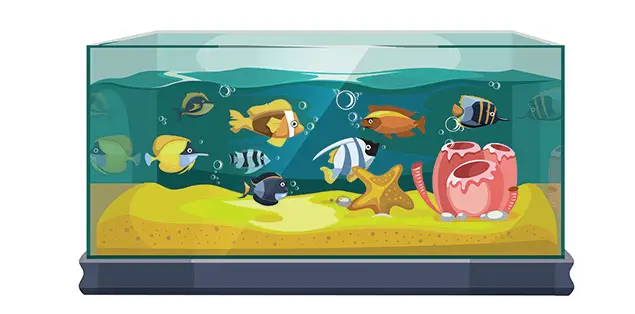
Multiple complications arise from having too many fish in one tank. For example, an overcrowded tank may lead to a poisonous environment, which can lead to cloudy tank water, behavioral conflicts, and discomfort for the fish.
Think of your aquarium as a micro-ecosystem, similar to a micro-lake, to better grasp the issue. Microorganisms in your tank break down trash, while the filtration system acts like the lakes’ streams and springs do, cleaning and aerating the water as it goes.
Like a lake, your aquarium can only hold so much life. Therefore, a steady supply of freshwater makes a lake more resilient. If your tank is a closed environment with no fresh water flowing in, once things go out of whack, it can’t get back in balance on its own.
Driftwood Leaching Tannins
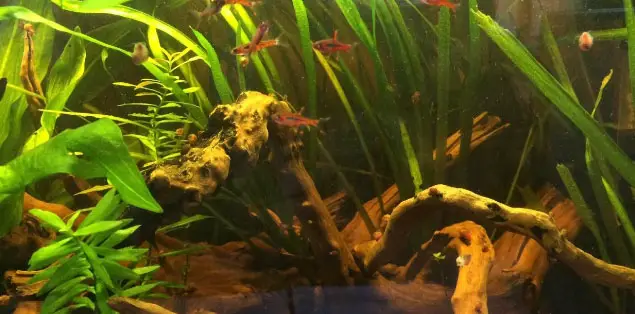
You may not have made a care error, but if your tank becomes foggy, it might be because you don’t know enough about your tank’s decorations. Natural driftwood is a wonderful addition to any aquarium. Fish will like nibbling or rasping on it since it looks so good. For those with hard water sources, like ours, driftwood may help lower the pH of the tank’s water just a little.
A yellowish tea-like hue may appear in your tank water if you’ve just added a piece of driftwood to it. This is because driftwood, particularly commercially accessible forms like African Mopani, releases tannins into the tank water.
It will not harm the fish, so you may wipe the sweat from your forehead and go about your day. Nonetheless, if you don’t like the color of your tank but like the driftwood, there are a few ways to fix it.
Why Is My New Fish Tank Cloudy?
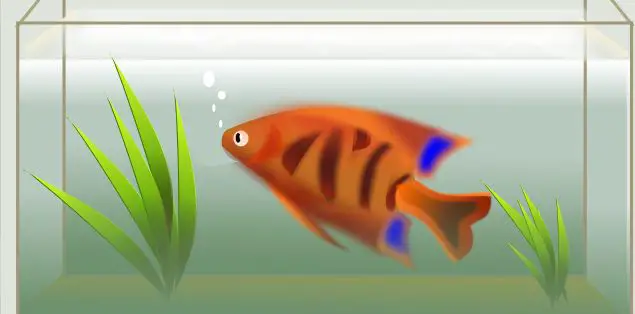
This might be due to the kind of substrate if you have a new fish tank. Epoxy-coated substrates in freshwater aquariums need complete cleaning, even if they are epoxy-coated. If marine aquarium substrates aren’t fully cleaned and washed, they might generate cloudy water in the aquarium.
You can thoroughly rinse substrates if you rinse them in tiny batches. For example, a foggy tank may be caused by dust and water on the aquarium glass if substrate cleaning is not done.
Cloudy water may be a result of the water itself. Toxic substances like heavy metals may be present in tap water. As many conditioners can neutralize chlorine, chloramines, ammonia, and metals, make sure you use one.
Reverse osmosis systems are also available, as well as pre-packaged aquarium water if you prefer. Remove most contaminants from your tap water source with a RO filter.
A cloudy aquarium is frequent once you set up a new aquarium. Ammonia and nitrites are being oxidized by helpful bacteria populating. An increase in nutrients may lead to a bacterium bloom even in an established aquarium. However, there is an increase in heterotrophic bacteria due to the increased food supply.
Ammonia forms through the decomposition of fish waste, decomposing plant detritus, and unconsumed food. As a result, they also leave behind a sticky biofilm that adheres to the aquarium’s surfaces. The rapid population growth of heterotrophs may lead to cloudiness in the water.
Allow the aquarium to go through this cycle independently for a fresh tank with no aquatic life. Reducing the quantity of food, doing a water change, and cleaning the substrate in an established tank can help reduce nutritional levels.
Why Is My Fish Tank Cloudy and Green?
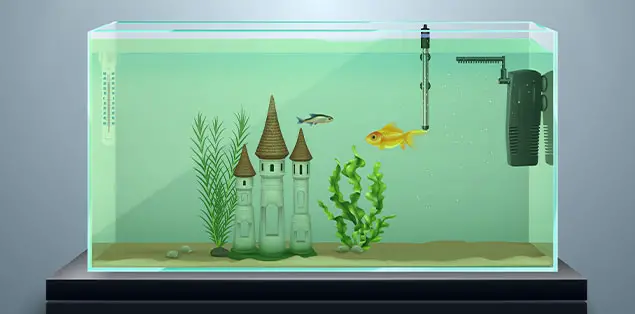
It’s a no-brainer that green water is because of the proliferation of algae. Knowing what causes a problem might help you get rid of or treat it more easily. The following factors cause water that appears green:
Too Much Light
Too much light is the most apparent culprit, and it is also the simplest remedy. For example, suppose you place the aquarium in direct sunlight or leave the lights on for an extended period. In that case, algae will begin to form in the tank. Use a timer to turn off your aquarium’s lights and transfer them to a spot that isn’t in direct sunlight.
Excess Nutrients
Algal development is also due to nutrients like phosphates and nitrates, which you must lower to win the struggle against algae. Changing the water supply may provide temporary comfort, but it is unlikely to cure the issue. To remove them from the aquarium, you must immediately deal with phosphate and nitrates.
Phosphates
Two sources of phosphorus include decomposing materials, such as fish, food, and water. Finding out whether your water has high levels of phosphates will help you determine whether or not there is an issue with the source. For example, it is necessary to utilize RO water or a phosphate remover if you have water that is naturally rich in phosphate. Therefore, it is better to feed your fish less and switch to a lower-in- brand.
Nitrates
As fish waste accumulates, nitrate levels in the aquarium naturally climb. Water changes are the only method to get rid of them. Therefore, you should maintain your tank’s filtration system clean and suitable for the size of your tank. Don’t overstock your aquarium to avoid continual battles with growing nitrate levels.
How Long Does It Take for Cloudy Aquarium Water to Clear?
If you change your aquarium water, you can instantly clear it. But if you use some other methods, it will take around 24 hours.
Is a Cloudy Fish Tank Harmful to Fish?
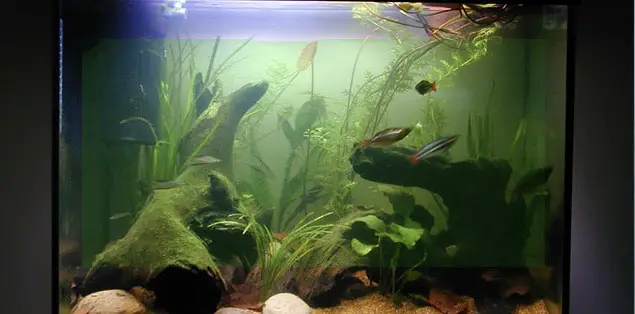
The cloudiness that develops in the water of an aquarium is not harmful to the fish that live there; rather, it indicates an imbalance and maybe a more serious issue. When you notice that the water in your aquarium is cloudy, you first need to test the water in your aquarium to evaluate the water quality.
Establish a starting point for your nutritional levels, and then take appropriate action based on the findings. For example, changing the water in the tank will assist restore the ecosystem’s natural equilibrium in almost all cases.
Final Words
If your fish tank water becomes cloudy, you’ll have to do investigative work.
Introducing fish to a tank that is not properly cycled may produce cloudiness due to the growth of bacteria in the tank. For example, suppose you expose the tank to direct sunlight for an extended period. In that case, floating algae may form, resulting in green water.
The dangers of using dried leaves and bogwood in your tank to mimic the aesthetic of natural habitats are not the only reasons. In addition, you can accidentally create an environment where the water develops a yellowish-brown hue due to tannins leaching into the water.
Read Also: How Long Can Fish Live Without Water?
